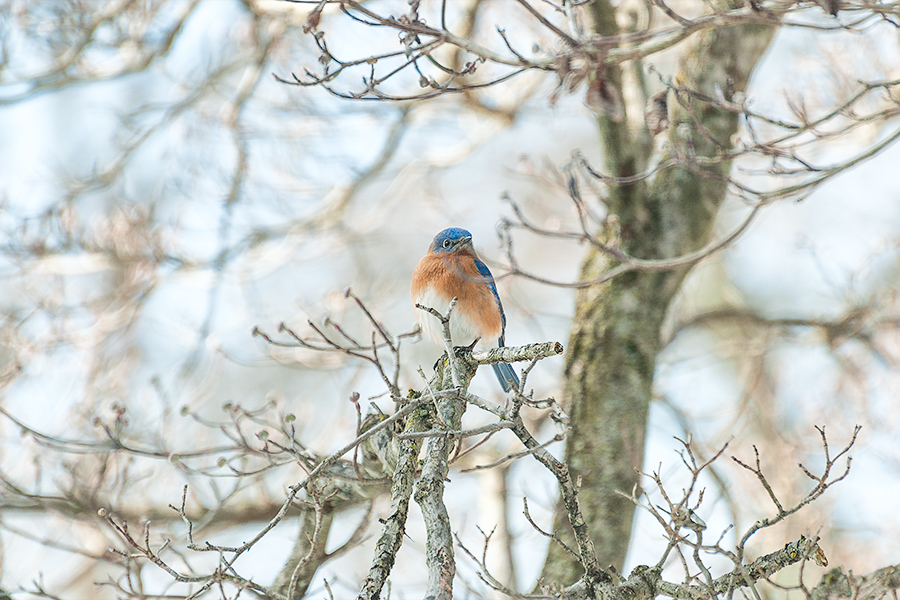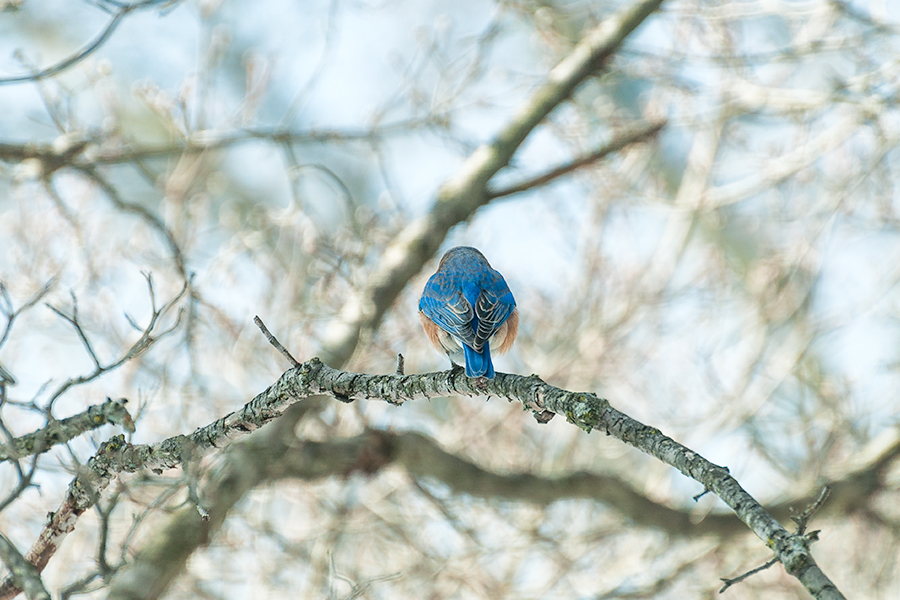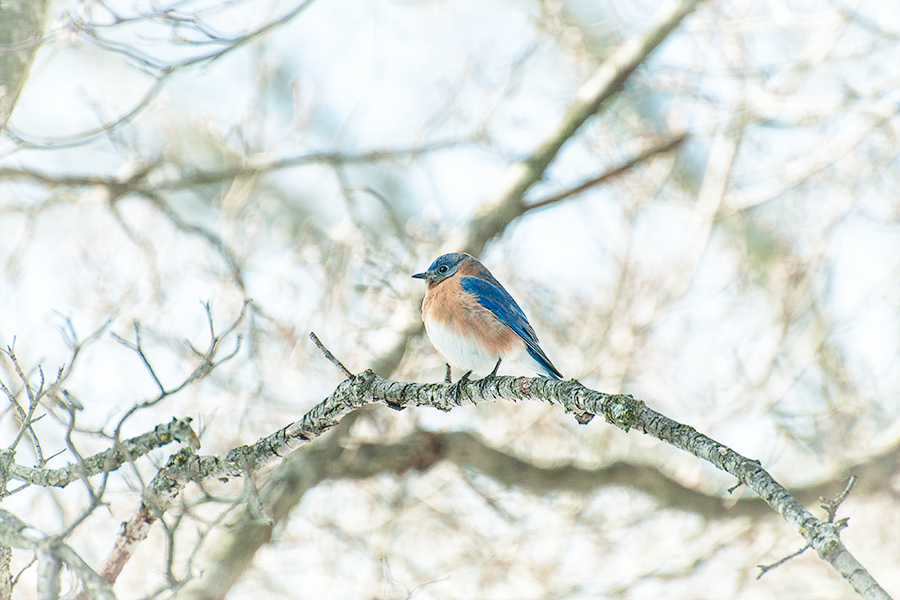10 Tips for Attracting Bluebirds
Nikon D90
Nikon D810
Nikkor 70-300mm - f/4.5-5.6 G AF-S
The bluebird is well named, for he wears a coat of the purest, richest, and most gorgeous blue on back, wings, and tail; no North American bird better deserves the name, for no other flashes before our admiring eyes so much brilliant blue. With their gorgeous colors, musical voices and gentle habits, who wouldn’t want to welcome these beauties into the backyard? Attracting bluebirds can take some time and patience. But once you’ve won them over, they’ll bring their special bluebird pizzazz to any yard or garden.
With kind treatment and a little encouragement, bluebirds may become very tame, confiding, and friendly. Bluebirds are generally regarded as gentle and lovable birds and rightly so, for such is their ordinary demeanor. If undisturbed, they are friendly with their avian neighbors. However, they can be aggressive, and even fierce in standing up for their rights against aggressors. In the competition for nesting sites, they have often been known to compete successfully with English sparrows and tree swallows, attacking and driving them away when they attempted to usurp their nesting place. Other larger birds are often driven away from the vicinity of the bluebirds' nest; the male stands guard while the female is incubating, feeds her occasionally, and drives away unwelcome intruders, even human beings.




There are some tips and tricks:
1. Open it up.
68% of a bluebirds' diet is made up of insects: grasshoppers, crickets (which is good for me since I am not a big fan of crickets), beetles, spiders, and caterpillars. They often watch from a low perch and then flutter down to take bugs from the ground. A wide expanse of open, chemical-free lawn provides ideal habitat. A very small yard or one with little or no open space will probably not be suitable for attracting bluebirds to nest, but if you provide the right food, such as mealworms, you may still see them at your feeders.
2. Go chemical-free.
Between spring and fall, a bluebird’s diet is mainly insects gleaned from the ground. Pesticides and other lawn chemicals are dangerous for birds that feed this way.
3. They also like fruit.
Flowering dogwood, holly, mulberry, wild grape, Virginia creeper, pokeweed, and Viburnum. (Although they will eat the fruit of multiflora rose and Japanese honeysuckle, these are invasive species, and should be eradicated). They may eat suet cakes (are blocks made from suet or a thick substitute mixed with other ingredients, such as corn meal, peanuts, fruits, or even dried insects). Bluebirds rarely eat birdseed, so they will occasionally take shelled sunflower and peanut chips only.
4. Offer mealworms.
Feeding live mealworms can pose some challenges, but bluebirds find them irresistible, even eating them from people’s hands.
5. Leave it alone.
Dead trees provide important nesting and roosting sites for bluebirds and a whole host of other cavity-nesting birds. Leave dead trees standing (or leave dead limbs on live trees) when it is safe to do so.
6. Just add water.
A simple birdbath is often enough, but bluebirds are partial to moving water, so even a small fountain or dripper will make your water feature more enticing.
7. Beware of roaming cats.
Each year, cats kill millions of songbirds. Newly fledged nestlings are especially susceptible, so be a good bird property owner and keep your cats indoors.
8. Plant native.
In winter, bluebirds add berries and other fruit to their diet, so planting trees and shrubs native to your area is a natural way to attract them.
It’s natural to assume that the bluebirds all gone south during winter, but this may not be the case. Some regularly stay through the winter as far north as Oregon, the southern Great Lakes and New England. They may switch habitats, however, gathering in small flocks and moving into open woods or juniper groves where wild fruits and berries will keep them fed in the cold. During the winter, small groups may roost together at night in tree holes or in other shelters. This is one good reason to consider leaving your nest boxes up for the winter season – attracting bluebirds may be possible even in the winter.
9. Nestbox.
If Eastern Bluebirds are in your area, but aren't coming to your yard, here are some tips for uneasy further step to attract those beauties.
BUT! Consider the following can cause problems in a bluebird nestbox: ants, blackflies/gnats, blow flies, cats, House Sparrows, fire ants, House Wrens, mice, nestbox design, pesticides, raccoons, rats, red squirrels, snakes, starlings, starvation, wasps, cold or hot weather, and woodpeckers. Bolded predators/problems are the most common. House sparrows, for instance, are very aggressive competitors for nesting space and will even kill bluebirds and other natives. So if you’re not prepared to evict all of the problems above, being a bluebird landlord may not be for you.
You can find an important guide how to build and protect Eastern Bluebird nestbox here
Bad Hair Day :)
10. Be patient.
One thing I can guarantee won't work is giving up. Bluebirds may not come right away, but it will be worth the wait.






















The bluebird is well named, for he wears a coat of the purest, richest, and most gorgeous blue on back, wings, and tail; no North American bird better deserves the name, for no other flashes before our admiring eyes so much brilliant blue. With their gorgeous colors, musical voices and gentle habits, who wouldn’t want to welcome these beauties into the backyard? Attracting bluebirds can take some time and patience. But once you’ve won them over, they’ll bring their special bluebird pizzazz to any yard or garden.